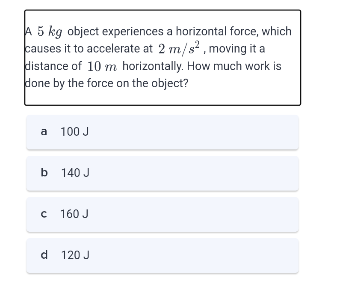A 5 kg object experiences a horizontal force, which causes it to accelerate at 2 m/s², moving it a distance of 10 m horizontally. How much work is done by the force on the object?

Understand the Problem
The question is asking to calculate the work done on a 5 kg object that is accelerating horizontally due to a force. To find the work done, we can use the formula for work, which is the product of force and distance. The force can be calculated using Newton's second law (F = ma), where 'm' is the mass and 'a' is the acceleration.
Answer
$$ W = 100 \, \text{J} $$
Answer for screen readers
$$ W = 100 , \text{J} $$
Steps to Solve
-
Calculate the Force To find the force acting on the object, use Newton's second law: $$ F = ma $$ Where ( m = 5 , \text{kg} ) and ( a = 2 , \text{m/s}^2 ). Substituting the values, we get: $$ F = 5 , \text{kg} \cdot 2 , \text{m/s}^2 = 10 , \text{N} $$
-
Calculate the Work Done Using the formula for work done: $$ W = F \cdot d $$ Where ( F = 10 , \text{N} ) and ( d = 10 , \text{m} ). Substituting the values, we have: $$ W = 10 , \text{N} \cdot 10 , \text{m} = 100 , \text{J} $$
-
Final Answer The total work done on the object is: $$ W = 100 , \text{J} $$
$$ W = 100 , \text{J} $$
More Information
The work done is calculated based on the force acting on the object and the distance it is moved. In this scenario, the force was calculated using the mass of the object and its acceleration, demonstrating the application of basic physics principles.
Tips
- Confusing mass and weight: Ensure to use the mass value (in kg) in calculations, not the weight (force due to gravity).
- Forgetting to convert units: Always double-check that the units are consistent when performing calculations.
AI-generated content may contain errors. Please verify critical information